February 2020
In this issue:
Based on the updated timeline for textbook adoption, the Oklahoma Academic Standards for English Language Arts will go under review this year. The first step for this process is to determine what stakeholders think of the standards in their current form.
We invite you to complete this short survey by Friday, February 28. You will get to rank how well the OAS for ELA meet their original guidelines of clarity, coherence, and purpose. You will also rank the revision level needed for the eight overarching standards. You can also propose revisions to specific objectives. You will also provide demographic information.
 Do you want to build your classroom library? The annual Friends of the Library book sale will take place later this month at the Oklahoma State Fairgrounds. Many books will be on sale for only $1 each.
-
Friday, February 21: Members Only Pre-Sale Event, 1-9 pm (Not a member? Not a problem. Click here to join today.)
-
Saturday, February 22: Open to General Public, FREE! * 9 am - 5:30 pm
-
Sunday, February 23: Open to General Public, FREE! * 9 am - 5:30 pm
The New York Times Teaching Project will begin with a three-day institute in New York City in July 2020, through which participants will get an insider’s view of The Times, explore dozens of ways to use the paper across the curriculum, and begin to create their own curriculum project that fits the needs of their students and schools.
The program will continue through the 2020-21 school year as participants continue to work on their curriculum projects, collaborate virtually, share ideas with their individual school communities and have opportunities to work with the Learning Network community as a whole.
-
This program is open to high school and middle school librarians and teachers of all subject areas who are employed full-time at an accredited school in the United States.
-
All full-time teachers or school librarians — whether from private, public or parochial settings — are welcome to apply, but The Times will give special consideration to those working in settings that have a schoolwide Title I designation.
-
If you are new to teaching with The Times and still want to apply, they welcome you, too — you just have to make a strong case for how The Times might enhance teaching and learning for your students. (And if you’re new to The Learning Network, you might read our “How to Use This Site” as well as a recent Times Insider piece on our work, “How The Learning Network Transforms Classrooms Across America.”)
The application is open. Space is limited. If you’re interested in participating, please read the information on the Learning Network webpage. Please be sure to review the Program Rules before submitting your application.
Deadline to apply: February 25, 2020
 |
Get ready to read together on World Read Aloud Day! On February 5, 2020 join in the celebration using #WorldReadAloudDay on social media and share how reading aloud has impacted your life. You could even just post a picture reading aloud to your students.
When I was in the classroom, I read aloud to middle school and high school students. I can still remember reading aloud Flush by Carl Hiaasen to my seventh graders and Runner by Carl Deuker to my eighth graders my very first year of teaching back in 2005. Later, I read A Monster Calls by Patrick Ness to my sophomores, even tearing up while reading the final chapter to them. In addition to novels, I sometimes read picture books to my students like Peter Reynolds' The Dot and Maira Kalman's Fireboat. [See the next section for more about The Dot.] My students so enjoyed read aloud time that sometimes I even let them gather around me on the floor like they used to do in elementary school days. I had their undivided attention as I read to them, changing my volume and inflection and making sure to show them the illustrations if it was a picture book.
You can visit the World Read Aloud Day website, and you can also read this Edutopia article about the benefits of reading aloud to middle school students. (I would argue these benefits apply to high school students as well.)
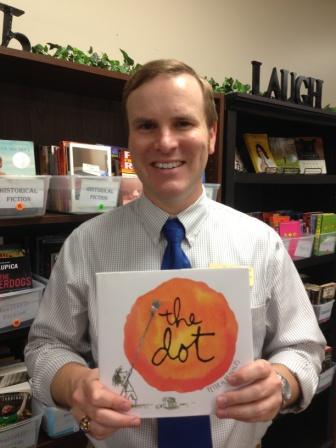
On the very first day of my Creative Writing 1 class at Deer Creek High School in 2013, I read The Dot by Peter Reynolds aloud to my students. I did my best to show them the pictures too, even though they’re in high school. My classes have students from all four grades, and this read-aloud was our first step toward building a writing community. I love this story for many reasons, and I highly recommend it if you’ve never read it. The audience is everyone, not just children.
After I finished reading the book, I asked students to think about the story. What lessons did it offer? How might it connect to this class? Why would I select this book for the first day of school?
I was so impressed with what my students came up with. I gave them time to discuss with a partner or a small group, but then we shared out as a whole class, which was made easier by our circular seating arrangement. I got so caught up in the discussion in 5th hour, I didn’t document what my students said. I knew it would equally good in 7th hour, so I used the talking feature on my smart phone to record my students’ responses. I’m posting some of them below in the order my students said them. Each student contributed and tried not to repeat any students before him or her. One of the best insights came at the very end.
- The more you try, the more creative you get.
- You’re more capable than what you believe you are.
- Sometimes all it takes is a start.
- Inspiration can come from different people and different things.
- Put in the effort to try something even if you don’t think you can.
- It’s yours, put your name on it, make it your own, it’s your writing.
- Something may not mean a lot to you, but it could mean a lot to other people.
- Don’t doubt yourself, be proud of your work.
- Our ideas grow because we brainstorm.
- The best standard you can reach is trying your very best.
[This entry originally appeared as post on my blog.]
|
 Perhaps you already use the free Google extension Grammarly to check your spelling and grammar. Grammarly recently introduced a new feature: a tone detector. This feature is only available in Gmail, and since it is new, it is not always accurate.
I did a little experiment to see if the tone detector could tell a difference between two passages from Harper Lee's To Kill a Mockingbird. First, I checked the tone of the opening paragraphs of the novel:
This analysis seemed accurate to me. Even though Scout is talking about Jem breaking his arm, she does so in an optimistic and friendly tone. Next, I jumped to the description of dreaded Mrs. Dubose from Chapter 11 and got this result:
This analysis was spot on! The intended purpose of Grammarly's tone detector is to help writers determine if they are using the tone they want in the emails they compose. Still, English teachers can use the detector for classroom purposes. Thanks to the ISTE Literacy PLN Journal for sharing information about Grammarly's Tone Detector.

TeenTribune, TweenTribune, TTEspañol and TTJunior (hereinafter collectively referred to as "TTribune") is a free online educational service offered by the Smithsonian for use by K-12 grade Teachers and students.
TTribune consists of daily news sites for kids, tweens, and teens, and includes text, photos, graphics, and audio and/or video materials prepared by the Smithsonian and others about current events, history, art, culture and science.
TTribune also includes lessons, instructional and assessment tools, and opportunities for the registered users to communicate with other participants.
Recent articles include:
Check out the TTribune website today! If you prepare your own Article of the Week, this website looks like a great resource.
|

Students are confused about how to evaluate online information. The COR curriculum provides free lessons and assessments that help you teach students to evaluate online information that affects them, their communities, and the world.
Download a single lesson or the full curriculum. Either way, you get classroom-ready materials. Integrate lesson plans into existing curriculum, or teach as a separate module.
The COR curriculum was developed by the Stanford History Education Group (SHEG) as part of MediaWise—a partnership of SHEG, the Poynter Institute, and the Local Media Association. The MediaWise collaboration is supported by Google.org as part of their Google News Initiative.
The goal of MediaWise is to provide educators with tools to help students evaluate online information. It is based on classroom research that shows that students in COR classrooms gain significantly in the knowledge and skills needed to determine the trustworthiness of digital content.
Check out the Civic Online Reasoning website today. I think it would be useful in teaching Standard 6: Research, Reading Strand, Objective 3:
- Grades 6-8: Students will determine the relevance, reliability, and validity of the information gathered.
- Grades 9-12: Students will evaluate the relevance, reliability, and validity of the information gathered.
|
 |
The New York Times recently announced its eight winning essays from its inaugural personal narrative contest, which netted over 8,000 entries.
The winning essays had a few things in common that set them apart:
"They had a clear narrative arc with a conflict and a main character who changed in some way. They artfully balanced the action of the story with reflection on what it meant to the writer. They took risks, like including dialogue or playing with punctuation, sentence structure and word choice to develop a strong voice. And, perhaps most important, they focused on a specific moment or theme — a conversation, a trip to the mall, a speech tournament, a hospital visit — instead of trying to sum up the writer’s life in 600 words."
Below is one of the eight winners, but you can read all of the winning essays at the New York Times website. These essays would make for some excellent mentor texts in your classrooms during a narrative essay unit.

Nothing Extraordinary
by Jeniffer Kim
It was a Saturday. Whether it was sunny or cloudy, hot or cold, I cannot remember, but I do remember it was a Saturday because the mall was packed with people.
I was with my mom.
Mom is short. Skinny. It is easy to overlook her in a crowd simply because she is nothing extraordinary to see.
On that day we strolled down the slippery-slick tiles with soft, inconspicuous steps, peeking at window boutiques in fleeting glances because we both knew we wouldn’t be buying much, like always.
I remember I was looking up at the people we passed as we walked — at first apathetically, but then more attentively.
Ladies wore five-inch heels that clicked importantly on the floor and bright, elaborate clothing. Men strode by smelling of sharp cologne, faces clear of wrinkles — wiped away with expensive creams.
An uneasy feeling started to settle in my chest. I tried to push it out, but once it took root it refused to be yanked up and tossed away. It got more unbearable with every second until I could deny it no longer; I was ashamed of my mother.
We were in a high-class neighborhood, I knew that. We lived in a small, overpriced apartment building that hung on to the edge of our county that Mom chose to move to because she knew the schools were good.
We were in a high-class neighborhood, but as I scrutinized the passers-by and then turned accusing eyes on Mom, I realized for the first time that we didn’t belong there.
I could see the heavy lines around Mom’s eyes and mouth, etched deep into her skin without luxurious lotions to ease them away. She wore cheap, ragged clothes with the seams torn, shoes with the soles worn down. Her eyes were tired from working long hours to make ends meet and her hair too gray for her age.
I looked at her, and I was ashamed.
My mom is nothing extraordinary, yet at that moment she stood out because she was just so plain.
Mumbling I’d meet her at the clothes outlet around the corner, I hurried away to the bathroom. I didn’t want to be seen with her, although there was no one important around to see me anyway.
When I finally made my way to the outlet with grudging steps, I found that Mom wasn’t there.
With no other options, I had to scour the other stores in the area for her. I was dreading returning to her side, already feeling the secondhand embarrassment that I’d recently discovered came with being with her.
I couldn’t have been more wrong. Mom was standing in the middle of a high-end store, holding a sweater that looked much too expensive.
She said, “This will look good on you. Do you want it?”
It was much too expensive. And I almost agreed, carelessly, thoughtlessly.
Then I took a closer look at the small, weary woman with a big smile stretching across her narrow face and a sweater in her hands, happy to be giving me something so nice, and my words died in my throat.
I felt like I’d been dropped into a cold lake.
Her clothes were tattered and old because she spent her money buying me new ones. She looked so tired and ragged all the time because she was busy working to provide for me. She didn’t wear jewelry or scented perfumes because she was just content with me.
Suddenly, Mother was beautiful and extraordinarily wonderful in my eyes.
I was no longer ashamed of her, but of myself.
“Do you want it?” My mom repeated.
“No thanks.”
|
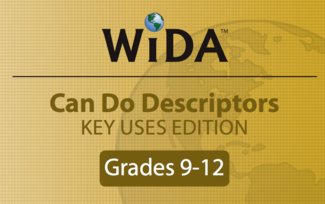
The Can Do Descriptors highlight what language learners can do at various stages of language development as they engage in the following contexts:
- Early care and education (ECE) English and Spanish language development
- K-12 English language development
- K-12 Spanish language development
Similar to the WIDA Language Development Standards, the Can Do Descriptors represent what learners can do with language across different content areas. Although the Can Do Descriptors relate to the Standards, they don’t replace them but supplement them during instruction.
Educators and early childhood practitioners can use the Can Do Descriptors in the following ways:
- Collaborate and engage in conversations about language for learning as children and youth move along the continuum of language development
- Advocate for language learners to have equitable access to developmentally appropriate content
- Differentiate instruction and classroom assessment
- Understand ACCESS for ELLs test scores
Download the Can Do Descriptors for your grade band today:
|

Since the 2014 publication of his first YA novel, When I Was the Greatest, Jason Reynolds has produced 15 books—a bounty that seems even more impressive considering he has also spent hundreds of days each year visiting schools and prisons, and speaking at conferences and conventions. In 2020, he will add a huge new responsibility to his schedule: on January 16, he was sworn in as the new National Ambassador for Young People’s Literature, taking the reins from Jacqueline Woodson, who has served in the post since 2018.
Reynolds plans to focus on empowering young people in small-town America with a platform he is calling “Grab the Mic: Tell Your Story.”
“When we ask about how to perpetuate reading, our knee-jerk reaction is to just insist that young people should read and I know for a fact that is not working,” Reynolds said. “I travel all over the place and there are lots of well-meaning people who are trying to help kids who don’t want to read, who live in households where reading is not valued, kids in prison, and definitely the wrong thing to do is to tell them to read. Youths don’t work that way. You tell them to read they’ll do anything but read.”
You can read the rest of the press release at this Publishers Weekly webpage.
|
Writing Prompt
A recent post on Twitter shared some famous poems that had been turned into limericks. Here are two examples:
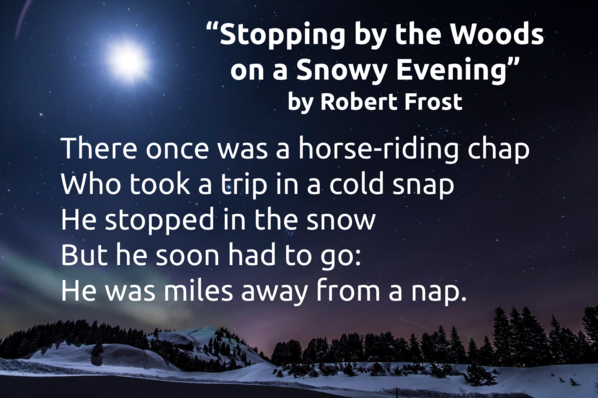
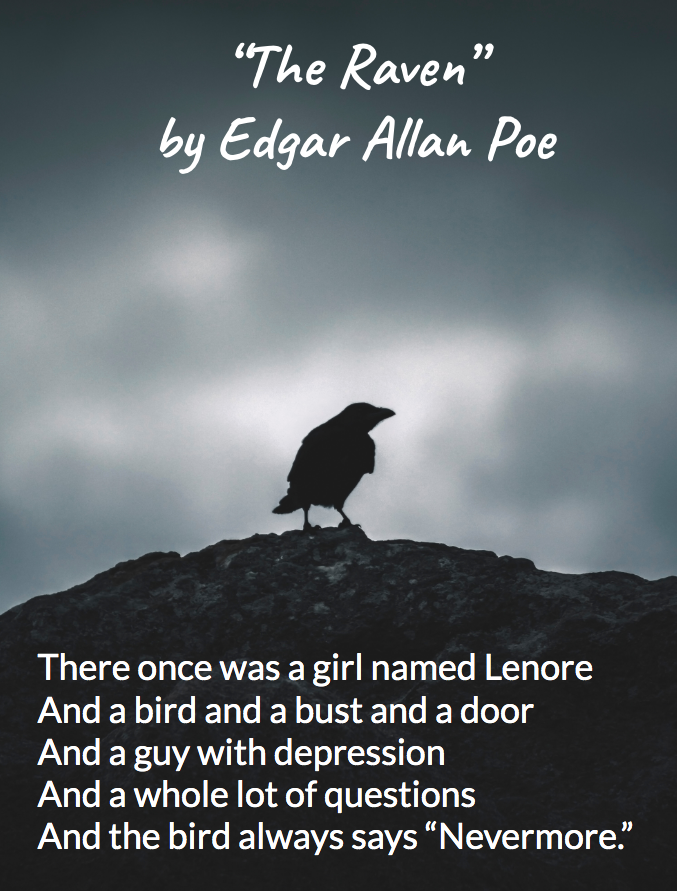 Now it's your turn. Pick a piece of literature—it doesn't have to be a poem—and turn it into a limerick. Need more details about the rules for writing a limerick? Check out the entry on the poets.org website. Send me your limericked piece of literature, and I might feature it in next month's newsletter.
Reading Quote
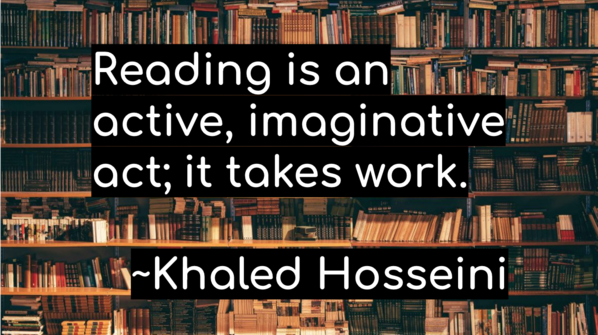 Comic

|